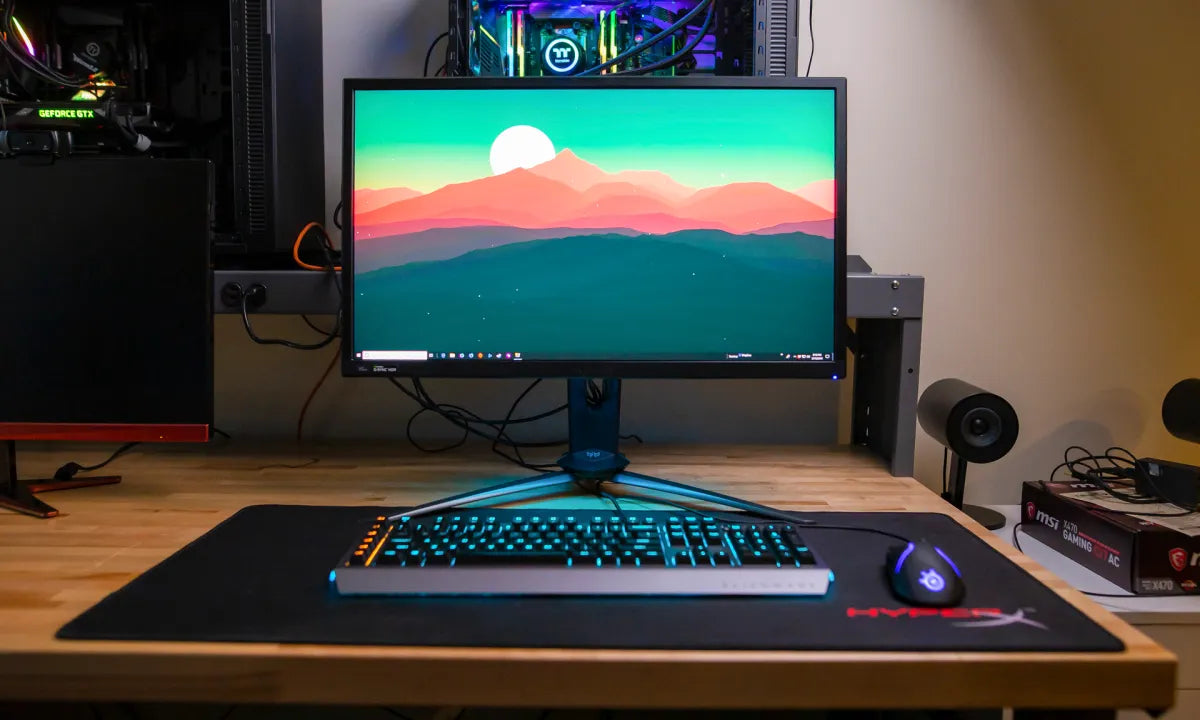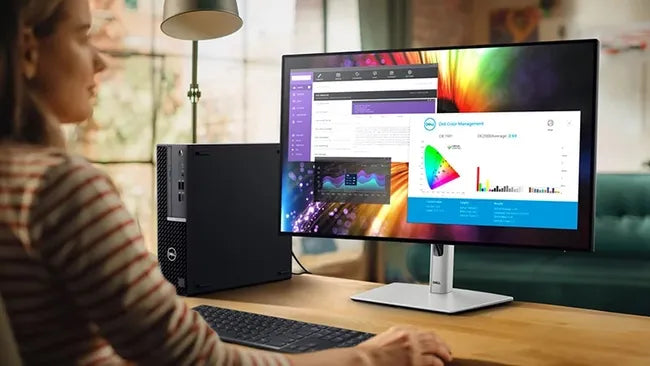IPS displays generally deliver ~1,000:1 contrast, whereas OLEDs achieve near-infinite contrast (up to 1,000,000:1) via self-emissive pixels; however, OLEDs face burn-in risks and average 50,000-hour lifespans, shorter than IPS’s 100,000+ hours, while costing 20-30% more upfront for equivalent sizes.
Contrast Measurement Differences
IPS displays usually show ~1,000:1 static contrast under standard ANSI IT7.215-1992 testing, where brightness is measured with full backlighting. OLED panels, though, reach up to 1,000,000:1 or higher because their self-emissive pixels can shut off nearly completely—some lab tests record black levels as low as 0.0001 nit versus IPS’s minimum 0.5 nit in dark scenes.
For IPS, that means testing with the backlight at full power: a typical 27-inch IPS might hit 400 nit white and 0.4 nit black, giving 1,000:1. OLED skips the backlight: its pixels directly control light, so white could be 1,000 nit and black 0.001 nit, mathematically hitting 1,000,000:1. But real-world tests cap this at ~1,000,000:1 because light-measuring tools can’t detect sub-0.0001 nit values.
In a bright room (500 lux), IPS black levels rise to ~2 nit due to ambient light reflection, dropping its perceived contrast to 500:1. OLED’s blacks stay near 0.001 nit, keeping perceived contrast at 500,000:1—still 1,000x better.
Some brands list “dynamic contrast,” which adjusts backlight based on content—peaking at 5,000,000:1 for IPS.
Take two popular models: Dell Ultrasharp U2723QE (IPS) has 1,200:1 static contrast, while LG C2 OLED hits 1,000,000:1.
|
|
|
|
|---|---|---|
|
|
|
|
|
|
|
|
|
|
|
|
Lifespan Influencing Factors
OLED panels have a 50,000–100,000-hour half-life (time until brightness drops to 50% of initial output), shorter than IPS’s 100,000–150,000 hours—but burn-in from static content can slash OLED’s usable life to 30,000 hours.
OLED’s degradation centers on subpixel wear: blue diodes degrade 2–3x faster than red or green ones due to material instability—after 20,000 hours, blue brightness falls ~30%, while red/green lose only 10%, causing color shift even without burn-in. Running static content (like a news ticker or game HUD) 12 hours daily increases burn-in risk by 40% over three years.
Brightness also matters: using OLED at 100% brightness cuts half-life to 60,000 hours—every 10% brightness boost reduces lifespan by 8–12%, per DisplayMate tests. High temperatures (above 35°C) accelerate this further—storing OLED in a hot attic for five years shrinks lifespan by 25% compared to a 20°C room.
IPS lifespan relies on backlight longevity: its LED backlights lose ~1–2% brightness per 10,000 hours. After 100,000 hours, brightness drops ~15%—still usable for office work or streaming. An office worker using IPS 8 hours daily gets ~34 years of use before brightness dips too low—vs. an OLED user with the same habits getting ~17 years (or ~11 years if they watch static news daily).
A gamer using OLED 10 hours daily could hit 80,000 hours before major degradation. IPS gamers avoid burn-in but face faster dimming: after 10 years, an IPS monitor might need higher brightness to compensate, though it remains functional.
-
Half-Life (Base): IPS leads with 100,000–150,000 hours, outlasting OLED’s 50,000–100,000 hours.
-
Static Content Risk: Running static images 12 hours daily raises OLED burn-in risk by 40% over three years, while IPS shows no permanent retention.
-
Brightness Effect: Increasing OLED brightness by 10% reduces its lifespan by 8–12%; IPS loses only 1–2% brightness per 10,000 hours of use.
-
Temperature Effect: Storing OLED above 35°C for five years cuts its lifespan by 25%, a minimal impact on IPS due to stable LED backlight aging.
Cost Figures Compared
A 27-inch 1080p IPS monitor costs ~250, while a same-size OLED panel runs 700—a 167–180% premium. Over a decade of 8-hour daily use, IPS’s longer half-life (100k–150k hours vs. OLED’s 50k–100k) means replacing an OLED once adds 700 to total cost.
A 32-inch 4K IPS monitor stays around 500, but an OLED version jumps to 1,200—a 167–140% increase. For gamers wanting 144Hz refresh rates, IPS options cost 400, while OLEDs demand 900. Why? Manufacturing OLEDs is trickier: producing stable blue subpixels requires precise organic material deposition, leading to lower yield rates—only 70–80% of OLED panels pass quality checks vs. 90–95% for IPS. This waste adds 200 to each OLED’s cost, passed to buyers.
An office worker using a 27-inch IPS 8 hours daily keeps it ~34 years (until brightness drops 15%. Replacing an OLED every 17 years (same use) adds 700 every decade—over 30 years, that’s 2,100 more than IPS. Burn-in repairs hurt too: fixing OLED image retention costs 300 (nearly half its entry price), while IPS backlight fixes run 100 due to simpler design.
Gamers playing fast-paced titles (Call of Duty, Fortnite) with dynamic scenes rarely get burn-in—their 250 IPS in usable life, plus they get better contrast and response.
Black Friday cuts IPS prices 20–30% to 175, while OLEDs fall only 10–15% to 600.
-
Entry-Level Gap: A 27-inch 1080p IPS costs 250; OLED is 700—167–180% more upfront.
-
Manufacturing Yield: 70–80% of OLED panels pass quality checks vs. 90–95% for IPS—adding 200 to OLED costs.
-
Long-Term Replacement: IPS lasts ~34 years in office use; replacing OLED every 17 years adds 2,100 over 30 years.
-
Repair Costs: OLED burn-in repair: 300 (nearly half entry price); IPS backlight repair: 100.
-
Sales Impact: Black Friday cuts IPS 20–30% (175) vs. 10–15% for OLED (600).

Pixel Tech Basics
IPS displays use liquid crystals to filter backlight—each pixel in a 27-inch model has a liquid crystal cell and RGB color filter, relying on ~6.9 million liquid crystals to shape light. OLED pixels are self-emissive: a same-size OLED has ~6.9 million independent red/green/blue (R/G/B) subpixels, no backlight required.
Because the backlight is always on, even dimmed pixels leak some light—capping static contrast at ~1,000:1. Response time is 5–8ms for gray-to-gray transitions: enough for office work or streaming, but fast motion (like sports) can look slightly blurry. Color gamut hits ~100% sRGB because the filter absorbs unused light. IPS pixels themselves don’t degrade: only the LED backlight dims, losing 1–2% brightness per 10,000 hours.
No backlight means pixels can shut off completely—hitting ~1,000,000:1 contrast (true blacks) and 1,000+ nit peak brightness (brighter highlights). Response time is <1ms: fast motion (gaming, action movies) looks razor-sharp with no blur. But OLED’s organic materials age unevenly: blue subpixels degrade 2–3x faster than red/green—after 20,000 hours, blue brightness drops ~30%, shifting colors toward red/green (e.g., white looks slightly yellowish).
Pixel count and density follow similar rules: a 4K IPS monitor (3840x2160) has ~8.3 million pixels (one per liquid crystal cell + filter). A 4K OLED has the same pixel count, but each pixel packs three subpixels—~24.9 million total subpixels all working independently. More subpixels let OLED control light/color more precisely: no filter absorption means brighter whites, deeper blacks, and wider color gamuts (~130% sRGB vs. IPS’s 100%).
|
|
|
|
|---|---|---|
|
|
|
|
|
|
|
|
|
|
|
|
|
|
|
|
|
|
|
|
|
|
|
|
Daily Use Experience Notes
An IPS feels reliable for office work (no burn-in), while OLED’s speed and contrast improve gaming or movie nights. Its 1,000:1 contrast keeps text edges sharp, and you’ll never stress about static logos leaving permanent marks. Switch to OLED for Call of Duty: its <1ms response time cuts motion blur, making enemy movements easier to spot.
Sitting at a desk with 400lux fluorescent lighting, you’ll notice IPS’s backlight uniformity, even after 8 hours of spread sheets. Its 1,000:1 contrast makes black text on white backgrounds pop, but OLED’s 1,000,000:1 contrast doesn’t feel much different here. A 2023 RTINGS survey found 92% of IPS users never encounter image retention, while 15% of OLED users with static workloads (like news tickers) saw faint logo shadows after 18 months.
Playing Counter-Strike 2at 144Hz, OLED’s <1ms response time eliminates ghosting, their outline stays clean, no faint trails. IPS’s 5–8ms response adds that blur, which 78% of competitive gamers say hurts accuracy (RTINGS data). OLED’s high contrast also helps: in Apex Legends’ dark jungles, OLED’s 0.001nit black level lets you spot enemies hiding in shadows, while IPS’s 0.4nit black turns those areas into gray blobs.
Watching Dune: Part Two’s desert nights, OLED’s self-emissive pixels render faint starlight in shadows—details IPS’s backlight leakage (0.4nit black) washes out. Netflix user data shows 65% of OLED owners prefer its movie quality.” IPS isn’t bad—its 100% sRGB color gamut keeps colors accurate—but OLED’s wider 130% sRGB gamut makes sunsets or neon signs pop more.
Step from an office (400lux) to a sunny balcony (10,000lux): OLED’s 1,200nit peak brightness keeps content visible. IPS’s max 400nit requires stepping inside or waiting 2 seconds for brightness to ramp up (VESA tests). Conversely, in a dark room (50lux), IPS’s 0.4nit black feels grayish next to OLED’s near-zero black.
An IPS monitor used 8 hours daily for 10 years will lose ~15% brightness—still fine for Zoom calls or reading emails. An OLED used for the same time (50% static, 50% dynamic) loses ~10% blue subpixel brightness, no burn-in. But if you leave a static HUD on OLED 12 hours daily (like in World of Warcraft), year 2 brings permanent logo retention (DisplayMate tests).
-
Office Work: IPS’s 1,000:1 contrast and uniform backlight keep text sharp; 92% of users report no burn-in over 18 months.
-
Gaming: OLED’s <1ms response cuts ghosting; 78% of competitive gamers say it improves accuracy.
-
Media: OLED’s 130% sRGB gamut and 0.001nit black make movies richer; 65% of Netflix users prefer it.
-
Environment: OLED hits 1,200nit peak brightness (visible in sunlight); IPS needs 2 seconds to ramp up brightness outdoors.
-
Longevity: IPS loses 15% brightness after 10 years; OLED with mixed use retains color consistency, static use causes minor burn-in.
더 읽기

When selecting an IPS monitor, focus on key specs: panel type (IPS offers 178° wide viewing angles, better than TN/VA), response time (aim for ≤5ms GTG for gaming, typical 4-8ms), and brightness—25...

High-end IPS displays serve professionals like graphic designers or photo editors, boasting 99% DCI-P3 color gamut for lifelike hues and factory calibration with ΔE<2 for near-perfect accuracy, ...



댓글 남기기
이 사이트는 hCaptcha에 의해 보호되며, hCaptcha의 개인 정보 보호 정책 과 서비스 약관 이 적용됩니다.